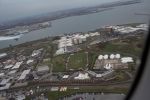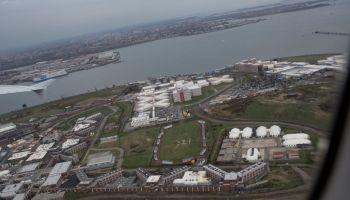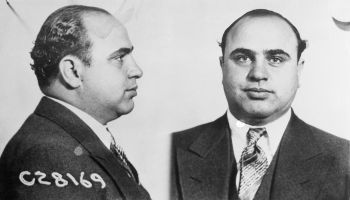VIA THE WASHINGTON POST:
Rescuers suspended efforts early Tuesday to find four missing coal miners in West Virginia after a mine explosion killed 25 others in the deadliest such disaster in the United States in decades.
West Virginia’s governor later said it could take until Wednesday evening for crews to drill the first of four boreholes into the mine from the surface to ventilate deadly gases built up inside and allow rescue teams to resume rescue and recovery operations.
Gov. Joe Manchin (D), West Virginia lawmakers and federal officials promised a thorough investigation of the mine’s safety record following reports that it was cited in the past month alone for dozens of violations, including the accumulation of highly combustible methane gas. Manchin described the explosion as “horrific” and said rails used to move heavy equipment inside the mine were left “twisted like pretzels” by the force and heat of the blast.
Asked in an afternoon news conference whether the accident was preventable, Kevin Stricklin, an administrator for the federal Mine Safety and Health Administration, said, “It is quite evident that something went very wrong here for us to have the magnitude of this explosion.” He said that “all explosions are preventable; it’s just making sure you have things in place to keep one from occurring.”
The blast Monday afternoon in the Upper Big Branch Mine, owned by Richmond-based Massey Energy Co. in Montcoal, W.Va., about 30 miles south of Charleston, left authorities with only slim hopes that the missing miners could be found alive more than 1,000 feet underground amid a buildup of toxic methane gas.
At least two miners were injured in the blast and remain hospitalized, officials said.
The gas buildup forced rescuers to call off efforts to reach a safety chamber deep inside the mine where officials hoped workers who survived the blast could have taken refuge. Such airtight chambers in the mine are stocked with food, water and four-day supplies of oxygen.
State and federal officials said it would be “a miracle” if anyone survived the explosion and the toxic gas. They planned to drill boreholes to ventilate the mine and remove the gas but cautioned that the operation could take as long as two days.
In Washington, President Obama said Tuesday he has told Manchin that “the federal government stands ready to offer whatever assistance is needed in this rescue effort.” Speaking at an Easter prayer breakfast at the White House, Obama asked those in attendance to “pray for the safe return of the missing, the men and women who’ve put their lives on the line to save them and the souls of those who’ve been lost in this tragic accident.”
Rep. George Miller (D-Calif.), chairman of the House Education and Labor Committee, and Rep. Lynn Woolsey (D-Calif.), who chairs the Workforce Protections Subcommittee, said they would work with federal agencies and convene hearings to look into the tragedy “at the appropriate time.” Rep. Nick Rahall (D-W.Va.) also vowed that “there will be hearings on this in Congress.”
In a morning news conference, Manchin was asked whether the four missing miners were near a rescue chamber when the explosion occurred. He replied: “That’s the hope. That’s the miracle and the hope and the prayers. . . . If there’s a shred of hope, it’s still a hope for a miracle.”
He cited the example of Randal McCloy Jr., who was found alive after being trapped for more than 40 hours in West Virginia’s Sago Mine following a 2006 explosion that killed 12 people and filled the shaft with carbon monoxide.
Stricklin told reporters that “this is still a rescue operation.” But he warned that “it does not appear that any of the individuals made it to a rescue chamber.”
He said later: “Based on what I’m seeing . . . I don’t think they had an opportunity to get to those. Unfortunately, this happened so quickly and [with] so strong of a force that I don’t think the miners” had any chance to reach a rescue chamber.
About 50 rescue personnel were pulled out at about 2:30 a.m. because of unsafe conditions in the mine, Stricklin said. Now, he said, workers must bulldoze their way to locations on the surface and bring in heavy equipment with which to drill boreholes 1,200 feet into the ground. He said it would take “about two days to get the boreholes into the mine,” contradicting Manchin’s initial estimate that the drilling could be completed in about 12 hours.
Manchin amended that estimate Tuesday afternoon, saying that the drilling could take “up until tomorrow evening.”
Officials said four holes would be drilled through earth and rock to reach places where the four missing miners were considered most likely to be, releasing the accumulated methane and carbon monoxide so that rescue workers could reenter the mine.
Stricklin said the rescue teams reached the first of two rescue chambers but found it empty, then had to retreat because the methane levels were too high to continue.
Thirty-one miners were in the area when the blast occurred, including the two who were brought out alive and hospitalized. Some of the victims may have been killed by the powerful blast, while others could have died from breathing the toxic gas, officials said.
“Tonight we mourn the deaths of our members at Massey Energy,” company chairman and chief executive Don Blankenship said in a statement after the 25 deaths were confirmed early Tuesday. He said rescue efforts “will resume as soon as conditions allow.”
Of the 25 confirmed dead, 11 bodies were recovered and identified, Manchin said, but 14 other bodies remain in the mine. He said authorities know the identities of the 14 dead miners and the four others still unaccounted for but have not yet released the names publicly.
Among the confirmed victims, Manchin told reporters, were the son, nephew and older brother of a miner who was just ending his shift and leaving the mine as his relatives were entering it. The two young men were 20 and 22, and the older brother was 49, Manchin said.
Another victim was Benny R. Willingham, 62, who had worked in coal mines for 30 years and was five weeks away from retiring, relatives told reporters. Upon his retirement, Willingham planned to take his wife on a cruise to the Virgin Islands, according to his sister-in-law, Sheila Prillaman. She told the Associated Press, “Benny . . . probably wouldn’t have stayed retired long. He wasn’t much of a homebody.”
Speaking to reporters outside an elementary school, Willingham’s relatives complained about what they described as a dearth of information from Massey Energy.
“Nobody will return our calls,” said Willingham’s daughter, Michelle McKinney, as she held a framed photo of her father. “We don’t know where my dad’s body’s at. We want some answers, and we want them today.”
The disaster currently ranks as the deadliest mine accident since 1984, when 27 people were killed in a fire at an Emery Mining Corp. mine in Orangeville, Utah.
If, as feared, the four missing miners are found to have perished and the death toll at Upper Big Branch rises to 29, it would be the worst U.S. mining disaster since 1970, when 38 were killed by an explosion at Finley Coal Co. in Hyden, Ky.
The cause of Monday’s explosion has not been determined, but a buildup of methane or coal dust was considered the likeliest culprit.
Although Massey Energy boasts on its Web site of achieving its best safety record in 2009 and beating the industry average for the sixth consecutive year, safety officials said the Upper Big Branch Mine, run by Massey subsidiary Performance Coal Co., has a history of violations for not properly ventilating methane gas.
Tony Oppegard, a mine-safety advocate based in Kentucky, said methane is a constant danger in coal mines, seeping out of the coal as it is cut. The gas is odorless and explosive and can be set off by static electricity when it reaches about 5 percent of the air in a mine.
To tell whether they are “in gas,” some miners carry electronic detectors called “spotters.”
Oppegard said the kind of mining done at Upper Big Branch — called “longwall” mining, in which a huge scraper runs along a seam of coal that be hundreds of feet long — is especially prone to producing methane. Other mines use machinery that drills straight ahead, cutting from a smaller surface at a time.
Oppegard said he was alarmed by press reports that the Upper Big Branch Mine had received 50 “unwarrantable” violations last year, a category of citation that he said indicated a high level of negligence.
The mine “did not have an enviable safety record,” Oppegard said. “When you see 50 of them, that’s a red flag.”
Federal inspectors fined the company more than $382,000 in the past year for repeated serious violations involving its ventilation plan and equipment at Upper Big Branch, the Associated Press reported. The violations also cover failing to follow the plan, allowing combustible coal dust to pile up and having improper firefighting equipment.
Before Monday’s explosion, at least three fatalities were reported at Upper Big Branch in the past 12 years. Two workers died in 1998 and 2001 in roof collapses, and a third was electrocuted in 2003 while repairing an underground shuttle car.
Massey Energy, one of the five biggest coal producers in the nation, lists 2.3 billion tons of coal reserves and says it “currently operates 35 underground mines and 12 surface mines in West Virginia, Kentucky, and Virginia.”
- Tunisia: Entertainment, Food, Languages, Places To Visit + More
- Egypt: Entertainment, Food, Languages, Places To Visit + More
- Morocco: Entertainment, Food, Languages, Places To Visit + More
- South Sudan: Entertainment, Food, Languages, Places To Visit + More
- Algeria: Entertainment, Food, Languages, Places To Visit + More














